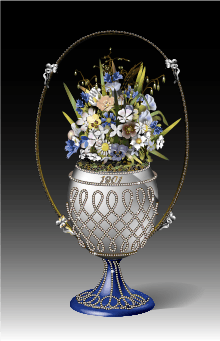Basket of Flowers (Fabergé egg)
| Basket of Flowers Fabergé egg | |
|---|---|
 | |
| Year delivered | 1901 |
| Customer | Nicholas II of Russia |
| Recipient | Alexandra Feodorovna |
| Current owner | |
| Individual or institution | Elizabeth II |
| Year of acquisition | 1933 |
| Design and materials | |
| Workmaster | Unknown[1] |
| Materials used | Silver, parcel gilt, oyster guilloché and blue enamel, gold, as well as hundreds of diamonds and opaque multi-colored emeralds[1] |
| Height | 23 cm |
| Width | 10 cm diameter |
| Surprise | None surviving |
The Basket of Flowers[note 1] egg is a jewelled enameled Easter egg made under the supervision of the Russian jeweller Peter Carl Fabergé in 1901. The egg was made for Nicholas II of Russia, who presented it to his wife, the Empress Alexandra Feodorovna.[2][3]
If the egg had a surprise (as all Fabergé eggs ever made did) there is no good record of what it was and none has survived with the current egg. It is not known what may have become of the surprise or when it may have been lost or how. The egg was executed by one of Fabergé's workmasters, but the name of the workmaster was not recorded and the egg itself bears no maker's marks or other hallmarks of its manufacture, at one point leading to some doubts as to its authenticity. It is designed as an egg-shaped silver-gilt oyster guilloche basket containing a bouquet of blossoms of mock orange, daisies, pansies, calla lilies, cornflowers, morning glories, and oats, with the date "1901" displayed on the front in diamonds. The egg stands on a blue enameled pedestal (not its original— the original white enamel was likely damaged during the Russian Revolution and has been replaced/ re-enameled with the current blue seen today), and is surmounted by an arcing basket handle of gold and diamonds. Base and egg are also decorated in a trellis work of diamonds.[3]
History
Though the existence of the egg has been clear since its manufacture, its authenticity as an "imperial" egg (i.e., an egg made in Fabergé's workshop and intended as an Easter gift for either the Czar's wife or his mother) was in doubt for some time. Beginning in 1949, some authorities began to identify the egg as being a non-imperial Fabergé creation; then, in 1979, other authorities began to claim that it was the work of another jeweller altogether, a Boucheron of Paris who had imitated Fabergé. In 1991 experts finally agreed that this egg was indeed the 1901 Easter gift of Nicholas II of Russia to his wife, and was made by the House of Fabergé for this purpose, officially making it an imperial Fabergé egg.
In 1933 the egg was sold by the Antikvariat (a Soviet institution) probably to Emanuel Snowman of London antique dealers Wartski, and it was acquired by Mary of Teck, and inherited by Queen Elizabeth II in 1953. It remains in the Royal Collection.[2]
See also
Notes
- ↑ Fabergé himself referred to this egg as an "Easter egg, white enamel, with bouquet of wild flowers" (emphasis not in original— see Lowes and McCanless, 2001), suggesting that the egg should be titled, "Basket of Wildflowers egg", but this ignores the fact that several of the flowers depicted are not, in fact, "wild" flowers; modern reliable sources do not mention the "wild" characteristic of the egg in its name, which is most often given as "Basket of Flowers egg."
References
- 1 2 Will Lowes; Christel Ludewig McCanless (2001). Fabergé Eggs: A Retrospective Encyclopedia. Scarecrow Press. p. 77. ISBN 978-0-8108-3946-5.
- 1 2 Fabergé in the Royal Collection. "Royal Collection - Basket of Flowers Egg". Retrieved 2 September 2011.
- 1 2 "1901 Flower Basket Egg". Mieks Faberge Eggs. www.wintraecken.nl. Retrieved 28 May 2016.
External links
| Wikimedia Commons has media related to Basket of Flowers (Fabergé egg). |
- Fabergé. "Basket of flowers egg". Royal Collection Trust. Inventory no. 40098.
- Images of the Basket of Flowers Egg, Buckingham Palace Royal Fabergé exhibition (Flickr).
- A detailed article on the 'Basket of Wild Flowers' egg from wintraecken.nl
- Details of the egg on the Royal Collection Trust online collection pages